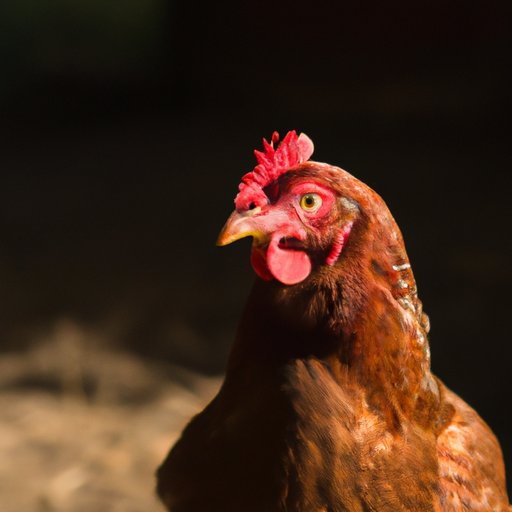I. Introduction
As a poultry farmer, keeping your chickens healthy and productive is a top priority. One critical aspect that plays a role in their growth and productivity is lighting. Understanding the optimal lighting conditions for chickens can be a challenge, and that’s why we’ve prepared this guide. In this article, we’ll explore how long chickens should be under a light and other essential factors, including the science behind a chicken’s circadian rhythm and lighting needs.
II. The Importance of Light for Growing Chickens: A Guide to Optimal Lighting Conditions
Since chickens are outdoor animals, they rely on natural light to regulate their biological processes. Exposure to light affects their growth, behavior, and productivity. The importance of natural light becomes even more crucial when chickens are kept indoors, in coops, for most of their lives. To ensure optimal development, farmers must provide supplemental lighting to mimic natural daylight cycles while also monitoring for proper durations and intensity levels.
III. How Many Hours a Day Should Your Chickens Be Under a Light? Expert Advice
Chickens require at least 14-16 hours of light each day, and the recommended intensity levels vary depending on the chicken’s age. Young chicks need 20-40 lux, while older hens require 5 lux. Underexposure to light can lead to reduced growth rates, suppressed immune systems, and lower egg production levels. On the other hand, overexposure to light can disrupt a chicken’s natural sleep and cause stress, leading to problems such as feather pecking and cannibalism.
IV. Illuminating the Science Behind Raising Healthy Chickens: A Lighting Strategy for Poultry Farmers
Chickens have a natural circadian rhythm that regulates their activity levels and biological function. Farmers can use this knowledge to optimize their lighting strategy by providing the right amount of light at the appropriate time of day. To do this, farmers can design a lighting program that aligns with the chicken’s natural rhythm using either natural or artificial lighting. For example, the light can be increased gradually in the morning and then decreased gradually in the evening to simulate natural daylight cycles. Proper implementation of lighting schedules ensures that their circadian rhythm is not disrupted and they remain healthy.
V. Inside a Chicken’s Mind: Understanding Their Circadian Rhythm and Lighting Needs
Chickens have a unique sleeping pattern that consists of short episodes of dozing throughout the day and longer sleeping periods at night. Observing their light and dark cycles and their behavior when exposed to different lighting conditions will give you an idea of the lighting strategy that works best for them. Chickens prefer natural lighting and have a strong reaction to bright lights which triggers their natural instinct to roost. Understanding these behaviors can help poultry farmers develop the best lighting strategies for their flocks.
VI. Easy Lighting Solutions for Raising Happy Chickens: Tips and Tricks for Beginner Farmers
Implementing proper lighting conditions doesn’t have to be challenging or expensive. There are several easy, cost-effective lighting solutions for new poultry farmers, including using fluorescent lights or light bulbs in coops and supplementing natural lighting with artificial light for consistency. Additionally, farmers need to adjust lighting based on seasonal changes. During the winter months, when sunlight is scarce, adding lighting support provides sufficient lighting to your flock. During the summer months, chickens may not require any additional lighting as they will receive enough natural sunlight exposure.
VII. Conclusion
In conclusion, providing optimal lighting conditions is crucial to the well-being and productivity of your chickens. A successful lighting strategy involves understanding the role of light in a chicken’s growth and development, identifying the right intensity and duration of light, and developing a lighting schedule based on a chicken’s natural circadian rhythm. Maintaining healthy lighting habits will promote egg production and improve the well-being of your flock. Remember, taking the time and effort to develop proper lighting solutions can help your chickens reach their full biological potential.
(Note: Is this article not meeting your expectations? Do you have knowledge or insights to share? Unlock new opportunities and expand your reach by joining our authors team. Click Registration to join us and share your expertise with our readers.)
